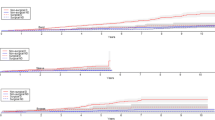Abstract
Background
Although the mortality from bariatric surgery is low, perioperative determinants of morbidity and mortality in the bariatric surgery population to date have not been fully defined. This study aimed to evaluate the factors capable of predicting perioperative mortality based on preoperative characteristics with a national patient sample.
Methods
From the American College of Surgeons National Surgical Quality Improvement Program (ACS-NSQIP) database, all the primary bariatric procedures performed between 2007 and 2009 were identified. Using univariate analysis, factors associated with increased perioperative (30-day) mortality were identified. Logistic regression was used to select correlates of 30-day mortality, which were subsequently integrated into a simplified clinical scoring system based on the number of comorbid risk factors.
Results
The study identified 44,408 patients (79 % women, 21 % men) with a mean age of 45 ± 11 years. The cumulative 30-day perioperative mortality rate was 0.14 %. The majority of the procedures performed included laparoscopic gastric bypass (54 %) followed by laparoscopic gastric banding (33 %) and open gastric bypass (7 %). Independent predictors associated with significantly increased mortality included age >45 years [adjusted odds ratio (AOR), 2.45], male gender (AOR = 1.77), a body mass index (BMI) of 50 kg/m2 or higher (AOR, 2.48), open bariatric procedures (AOR, 2.34), diabetes (AOR, 2.88), functional status of total dependency before surgery (AOR, 27.6), prior coronary intervention (AOR, 2.66), dyspnea at preoperative evaluation (AOR, 4.64), more than 10 % unintentional weight loss in 6 months (AOR, 13.5), and bleeding disorder (AOR, 2.63). Ethnicity, hypertension, alcohol abuse, liver disease, and smoking had no significant association with mortality in this study. Risk stratification based on the number of preoperative comorbid factors showed an exponential increase in mortality as follows: 0–1 comorbidities (0.03 %), 2–3 comorbidities (0.16 %), and 4 comorbidities or more (7.4 %).
Conclusion
This model provides a straightforward, precise, and easily applicable tool for identifying bariatric patients at low, intermediate, and high risk for in-hospital mortality. Notably, baseline functional status before surgery is the single most powerful predictor of perioperative survival and should be incorporated into risk stratification models.
Similar content being viewed by others
References
Flegal KM et al (2012) Prevalence of obesity and trends in the distribution of body mass index among US adults, 1999–2010. JAMA 307(5):491–497
Allison DB et al (1999) Annual deaths attributable to obesity in the United States. JAMA 282(16):1530–1538
Sjostrom L et al (2012) Bariatric surgery and long-term cardiovascular events. JAMA 307(1):56–65
Sjostrom L et al (2004) Lifestyle, diabetes, and cardiovascular risk factors 10 years after bariatric surgery. N Engl J Med 351(26):2683–2693
Pories WJ et al (1995) Who would have thought it? An operation proves to be the most effective therapy for adult-onset diabetes mellitus. Ann Surg 222(3):339–350; discussion 350–352
Meijer RI et al (2011) Bariatric surgery as a novel treatment for type 2 diabetes mellitus: a systematic review. Arch Surg 146(6):744–750
Marti-Valeri C et al (2007) Improvement of associated respiratory problems in morbidly obese patients after open Roux-en-Y gastric bypass. Obes Surg 17(8):1102–1110
Morino M et al (2007) Mortality after bariatric surgery: analysis of 13,871 morbidly obese patients from a national registry. Ann Surg 246(6):1002–1007; discussion 1007–1009
DeMaria EJ, Portenier D, Wolfe L (2007) Obesity surgery mortality risk score: proposal for a clinically useful score to predict mortality risk in patients undergoing gastric bypass. Surg Obes Relat Dis 3(2):134–140
DeMaria EJ et al (2007) Validation of the obesity surgery mortality risk score in a multicenter study proves it stratifies mortality risk in patients undergoing gastric bypass for morbid obesity. Ann Surg 246(4):578–582; discussion 583–584
American College of Surgeons National Surgical Quality Improvement Program (2009) User Guide for the 2008 Participant Use Data File. http://acsnsqip.org/participant-use-data-file/. Accessed 2 Oct 2009
Santry HP, Gillen DL, Lauderdale DS (2005) Trends in bariatric surgical procedures. JAMA 294(15):1909–1917
Buchwald H, Estok R, Fahrbach K, Banel D, Sledge I (2007) Trends in mortality in bariatric surgery: a systematic review and meta-analysis. Surgery 142(4):621–632
Hinojosa MW, Varela JE, Smith BR, Che F, Nguyen NT (2009) Resolution of systemic hypertension after laparoscopic gastric bypass. J Gastrointest Surg 13:793–797
Sugerman HJ, Wolfe LG, Sica DA, Clore JN (2003) Diabetes and hypertension in severe obesity and effects of gastric bypass-induced weight loss. Ann Surg 237(6):751–758
Crawford RS, Cambria RP, Abularrage CJ, Conrad MF, Lancaster RT, Watkins MT, LaMuraglia GM (2010) Preoperative functional status predicts perioperative outcomes after infrainguinal bypass surgery. J Vasc Surg 51(2):351–358
Albright EL, Davenport DL, Roth JS (2012) Preoperative functional health status impacts outcomes after ventral hernia repair. Am Surg 78(2):230–234
Disclosures
Muhammad Asad Khan, Roman Grinberg, Stelin Johnson, John N. Afthinos, Karen E. Gibbs have no conflicts of interest or financial ties to disclose.
Author information
Authors and Affiliations
Corresponding author
Rights and permissions
About this article
Cite this article
Khan, M.A., Grinberg, R., Johnson, S. et al. Perioperative risk factors for 30-day mortality after bariatric surgery: is functional status important?. Surg Endosc 27, 1772–1777 (2013). https://doi.org/10.1007/s00464-012-2678-5
Received:
Accepted:
Published:
Issue Date:
DOI: https://doi.org/10.1007/s00464-012-2678-5




